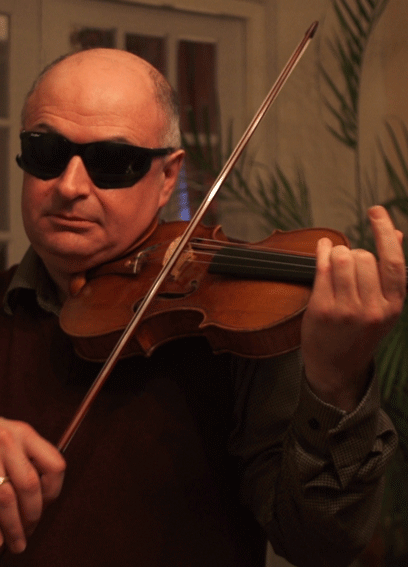Following a controversial 2010 study in Indianapolis, researchers in Paris invited ten professional musicians to compare twelve instruments, in this investigation from 2014

Discover more lutherie articles here
A modern instrument was the clear winner and a Stradivarius the loser in a double-blind test of old Italian and new violins, conducted at the Auditorium Coeur de Ville in Vincennes, Paris. In a follow-up to the controversial experiment conducted in Indianapolis in 2010, ten professional soloists compared the tonal qualities of twelve instruments – six by 18th-century Italian luthiers and six by contemporary makers. The results, published on 7 April in the Proceedings of the National Academy of Sciences, confirmed those of the 2010 study, which showed a general preference for new violins and that players were unable to reliably distinguish new violins from old.
French acoustics specialist Claudia Fritz, US violin maker Joseph Curtin and strings expert Fan-Chia Tao, who led both studies, made a number of changes to the test set-up. ‘One criticism was that only players of the top rank could be expected to get the best out of a Strad, and to give an informed judgement about tone quality,’ said Curtin. ‘Secondly, top-level musicians are more experienced at playing many instruments under different conditions.’
This time the number of instruments was increased from six to twelve and only ‘renowned soloists’ were invited to participate. Instead of a hotel room the tests took place in a rehearsal room and concert stage, and the evaluation periods were increased to two 75-minute sessions. Participants compared six new instruments with five Strads and one by an 18th-century Italian master.
The players were told to judge each violin as if they were looking for an instrument that could best replace their own for an upcoming concert tour. Each player wore modified welders’ goggles and performed under very low ambient lighting, to ensure they could not identify the violins by sight. The soloists used their own bows throughout the study, and were allowed to compare test violins with their own instruments whenever they wished. When they were on stage, they were also given the option of playing with piano accompaniment, getting feedback from a chosen listener, and hearing the violins played by another soloist.
In one test the participants were asked to reject instruments they didn’t like and rank their four favourites in order, with the researchers awarding four points to each player’s top instrument. Rejected instruments had a point deducted from their overall score. In the second test all the violins were tested again in the concert hall. At the end of the test the players were given a series of violins and 30 seconds to guess whether it was old or new. In total, 33 of the soloists’ guesses were wrong and 31 right, with 5 indeterminate.
The final results showed that one modern instrument garnered a total of 26 points, being the top choice for four players, second choice for another four, and rejected by two. Conversely, a Stradivari ended up with a score of -9. Its closest rival was a modern instrument, which had a score of -7.
The results revealed the two most-preferred instruments to be modern, while in third place was a violin from Stradivari’s ‘golden period’. At the opposite end of the scale a Stradivari drew the poorest result and a modern instrument was placed second-last.
‘Soloists readily distinguished instruments they liked from those they did not but were unable to tell old from new at better than chance levels,’ the report concluded. ‘Given the stature and experience of our soloists, continuing claims for the existence of playing qualities unique to old Italian violins are strongly in need of empirical support.’
The research team is preparing two further papers based on the study. The first will cover projection in the hall. The second will explore correlations between the players’ evaluations and those of the listeners in the audience.
The soloists taking part in the study were: Olivier Charlier (France), Pierre Fouchenneret (France), Yi-Jia Susanne Hou (Canada), Ilya Kaler (pictured, Russia), Elmar Oliveira (US), Tatsuki Narita (France), Solenne Païdassi (France), Annick Roussin (France), Giora Schmidt (US), and Stéphane Tran Ngoc (France).
‘For me, the really important finding is that whereas soloists readily separate instruments they like from those they don’t, they seem unable to tell old Italian instruments from new ones,’ said Curtin. ‘Whatever it is that top players are looking for in a violin, it is clearly not related to age or country of origin.’
Photo: Russian violinist Ilya Kaler © Stefan Avalos
Subscribe to The Strad or explore our Digital Archive. To purchase back issues click here.
Read: From Stradivari to Zygmuntowicz: the instruments of Music@Menlo
Read: How I made my own cello - Bamberg Symphony’s co-principal cellist Nikola Jovanovic
An exclusive range of instrument making posters, books, calendars and information products published by and directly for sale from The Strad.
The Strad’s exclusive instrument posters, most with actual-size photos depicting every nuance of the instrument. Our posters are used by luthiers across the world as models for their own instruments, thanks to the detailed outlines and measurements on the back.
The number one source for a range of books covering making and stringed instruments with commentaries from today’s top instrument experts.
American collector David L. Fulton amassed one of the 20th century’s finest collections of stringed instruments. This year’s calendar pays tribute to some of these priceless treasures, including Yehudi Menuhin’s celebrated ‘Lord Wilton’ Guarneri, the Carlo Bergonzi once played by Fritz Kreisler, and four instruments by Antonio Stradivari.












































No comments yet